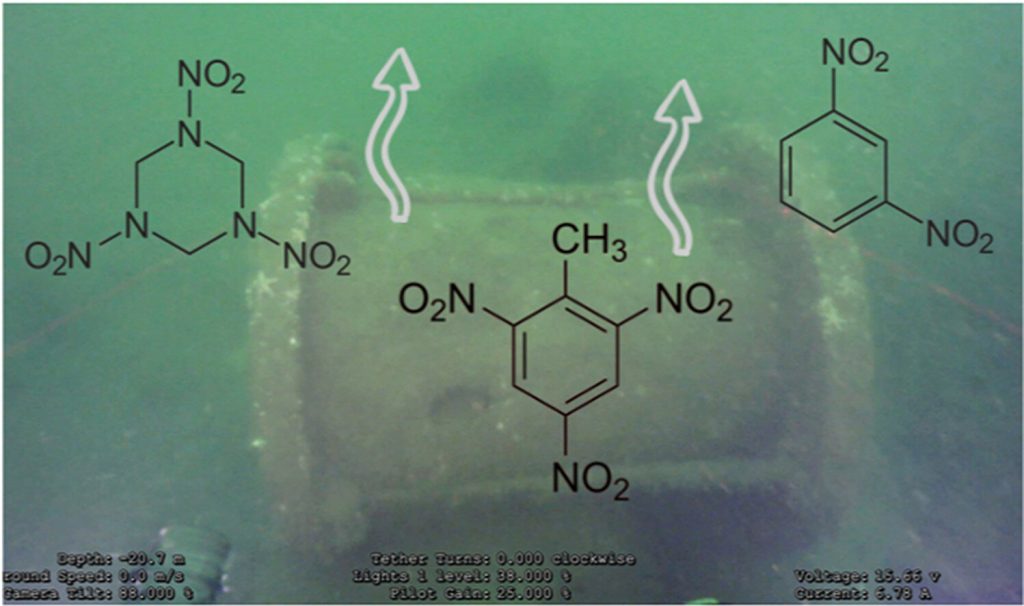
It is estimated that about 300,000 metric tons of unexploded ordnance (UXO) remain in the German Baltic Sea. Most of this originates from deliberate dumping after the end of the Second World War. These dumping sites are well documented, with much of the ordnance lying visibly on the seabed, allowing it to be mapped and documented using underwater robots.
However, explosive compounds are spreading beyond these dumping sites. As corrosion progresses, contamination is expected to increase, heightening risks if these legacy munitions are not removed. Rising temperatures and increased storm activity due to climate change further accelerate the release of these explosive chemicals.
Toxins found in almost every sample
A new study from the GEOMAR Helmholtz Center for Ocean Research Kiel, published in Chemosphere, highlights the long-term environmental contamination caused by unexploded ordnance in the south-western Baltic Sea. Water samples were taken from the region in 2017 and 2018, including from the Bay of Kiel and the Bay of Lübeck.
Ammunition-related chemicals were detected in almost every water sample. The concentrations detected were generally well below drinking water limits or toxicological thresholds for marine organisms. In some cases, however, concentrations approached critical levels.
“Unexploded ordnance contains toxic substances such as TNT (2,4,6-trinitrotoluene), RDX (1,3,5-trinitro-1,3,5-triazine), and DNB (1,3-dinitrobenzene), which are released into the seawater when the metal casings corrode,” explains lead author Dr. Aaron Beck, a geochemist at GEOMAR. “These compounds pose a threat to the marine environment and living organisms as they are toxic and carcinogenic.”
Regional differences in contamination
Due to variations in the types of munitions dumped, regional differences in contamination levels were observed: Particularly high concentrations of TNT were measured in the Bay of Kiel, while RDX and DNB were more prevalent in the Bay of Lübeck. Most munitions-related chemicals were found in dissolved form rather than bound to suspended particles or sediments.
The researchers estimated that the current amount of dissolved munitions chemicals in the region is around 3,000 kilograms. Without removal action, the contamination is expected to increase as metal casings continue to corrode, releasing more and more toxic compounds. This process is projected to continue for at least 800 years.
A global environmental issue
The study emphasizes that chemical contamination from legacy munitions is an international problem. The researchers recommend that dumped ordnance be classified as “historical contaminants of emerging concern” and that they be addressed through targeted remediation efforts.
Beck states, “Unlike diffuse pollution sources, UXO exists in a concentrated, already packaged form. This means it can be physically removed from the environment.”
Germany’s munitions clearance operations could serve as a model for the removal of such hazardous waste around the world. “With war relics, at least one environmental stressor can be permanently eliminated from the marine ecosystem.”
The German government launched a pilot program for the recovery and environmentally sound disposal of legacy munitions. With a budget of 100 million euros, this was the first targeted effort worldwide to remove munitions remnants from the sea. The pilot clearance operation began in autumn 2024 in the Bay of Lübeck. The next step will be to use the data collected to develop an autonomous clearance platform that will treat and incinerate the ordnance at sea.
More information:
Aaron J. Beck et al, Widespread environmental contamination from relic munitions in the southwestern Baltic Sea, Chemosphere (2025). DOI: 10.1016/j.chemosphere.2025.144115
Provided by
Helmholtz Association of German Research Centres
Citation:
Impact of unexploded ordnance in the Baltic Sea: Study detects toxic munitions chemicals in water samples (2025, February 26)
retrieved 26 February 2025
from https://phys.org/news/2025-02-impact-unexploded-ordnance-baltic-sea.html
This document is subject to copyright. Apart from any fair dealing for the purpose of private study or research, no
part may be reproduced without the written permission. The content is provided for information purposes only.








